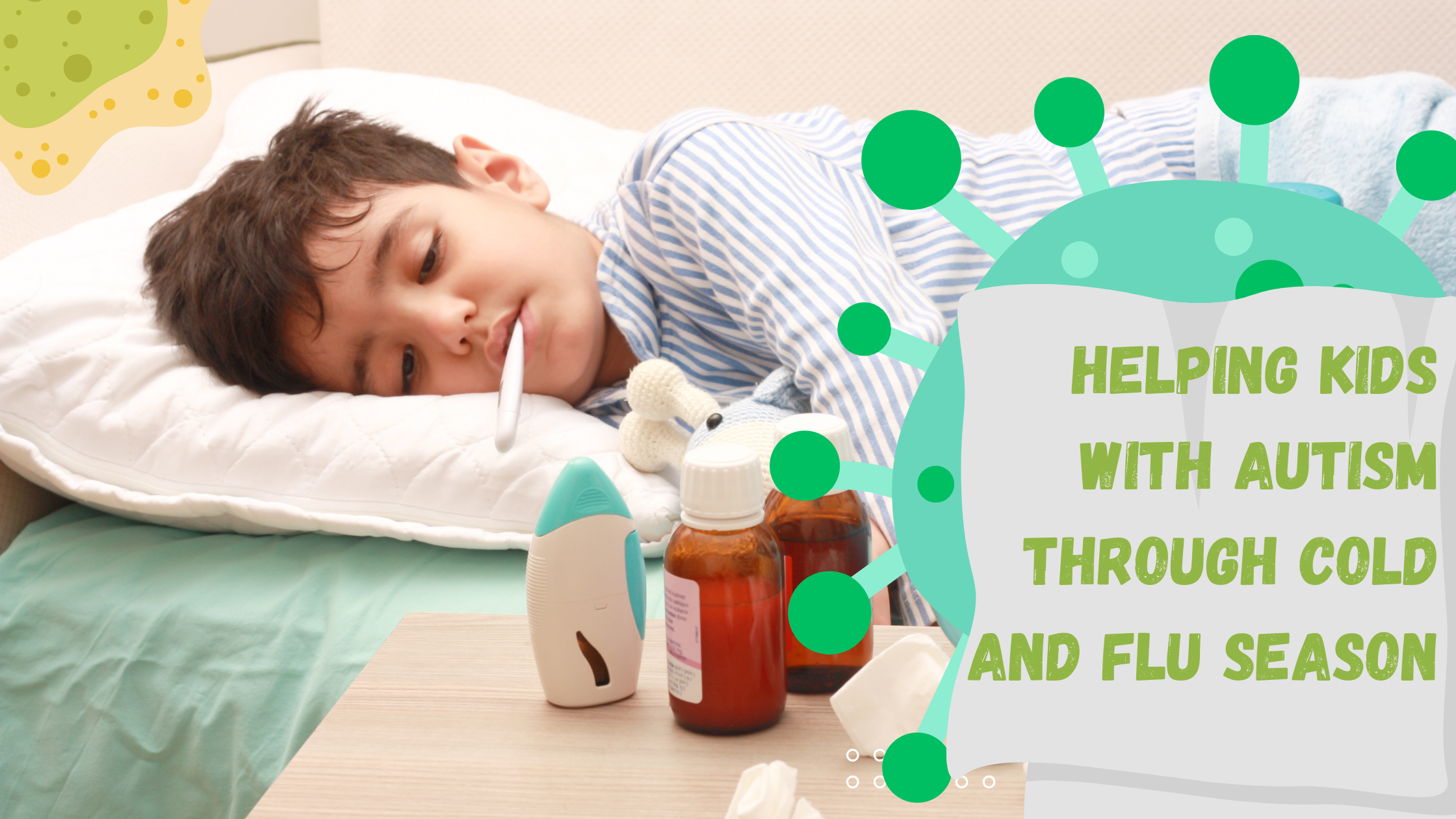Helping Kids with Autism Through Cold and Flu Season: Tips for Parents
November 11, 2024

Cold and flu season brings challenges for everyone, but parents of children with Autism Spectrum Disorder (ASD) may face extra hurdles. From managing sensory sensitivities around medications to adapting routines for illness, supporting kids through this time of year requires some creative planning. Here are practical tips to help you navigate cold and flu season, making it as comfortable and stress-free as possible for your child (and for you).
1. Prevent Illness with a Routine That Works for Your Child
Prevention is key, but standard hygiene routines can be a challenge for some kids with autism, who might find certain sensations uncomfortable. Integrating hygiene in a sensory-friendly way can make things easier.
Helpful tips:
- Handwashing fun: Choose a soap with a mild scent and soft texture, and make it a game by singing a favorite song for 20 seconds. This can turn a chore into a moment of fun.
- Hand sanitizer alternatives: If handwashing is difficult, try a hypoallergenic hand sanitizer with minimal scent. Keep a small, sensory-friendly bottle in your bag for when you’re out and about.
- Visual cues: Create a simple, visual routine chart for handwashing and covering coughs, with illustrations or photos of each step. This helps reinforce the routine in a structured way.
2. Prepare for Medications and Remedies in Advance
If your child needs medication, the unfamiliar tastes, smells, and textures can be overwhelming. Preparing them in advance (and maybe preparing yourself with some patience!) can make this process smoother.
Tips for medication time:
- Practice ahead: Before your child is sick, practice taking medicine by using a spoon with water or juice. This way, the experience won’t be entirely new when they’re not feeling their best.
- Flavored options: Many pharmacies offer flavoring options that can make medicine more palatable. Check with your pharmacist to see if there are mild flavors that might suit your child’s preferences.
- Positive reinforcement: Offer a small reward, like a sticker or extra storytime, after taking medication. Positive associations help make it less stressful next time.
3. Create a Sick-Day Routine That Feels Familiar
When illness disrupts their usual schedule, kids with autism can feel uneasy. Creating a “sick-day” routine that feels familiar, even if it’s different from their regular schedule, can help ease the transition.
Setting up a sick-day routine:
- Morning check-in: Start with something they enjoy, like quiet reading or favorite music. This keeps their morning structured, even if they’re not going to school or therapy.
- Activity zones: Set up cozy spots in your home for activities like puzzles, coloring, or quiet time with a favorite show. These areas can help them feel at ease and in control.
- Scheduled rest breaks: Include “rest time” in their schedule, even if it’s just lying down with a book or blanket. These regular rest breaks help build the routine around recovery.
4. Sensory-Friendly Ways to Address Symptoms
Cold and flu symptoms—like coughs, congestion, and sore throats—are uncomfortable for anyone, but they can be particularly tough for children with ASD who experience sensory sensitivities.
Strategies for symptom relief:
- Warm (not hot) compresses: If congestion is an issue, try using a warm washcloth on their face or a gentle steam session in a bathroom with the shower running. Warmth can help ease discomfort without being overwhelming.
- Choose textures carefully: Look for soft tissues or hypoallergenic options for runny noses. Some children may prefer a specific fabric texture, like cotton cloths, over standard tissues.
- Honey remedies: For children over one year old, honey is a natural way to soothe a sore throat. You can mix it with warm water or their favorite drink to help with coughs, avoiding the battle over store-bought syrups.
5. Prepare for Doctor Visits
If your child needs to visit the doctor, a little planning can make the experience less stressful. Familiarizing them with what to expect and offering choices can help reduce anxiety.
Doctor visit preparation tips:
- Practice play: Use a toy doctor kit to role-play a checkup. This helps your child understand what might happen at the office, making it feel less intimidating.
- Visual schedules: Use a simple picture-based schedule outlining the doctor’s visit steps, like arriving, waiting, seeing the doctor, and heading home.
- Provide choices: Give your child choices where possible, like picking their own mask to wear or choosing a small toy to bring along. This gives them a sense of control, even in a new situation.
6. Create a Care Kit with Comfort Items
Illness brings discomfort, so a small care kit with familiar items can offer comfort and distraction. Choose items that soothe your child, helping them feel secure and distracted from symptoms.
What to include in a care kit:
- Favorite sensory items: Small items like fidget toys, stress balls, or textured blankets can offer comfort.
- A calming playlist or stories: Audiobooks, soothing music, or recorded bedtime stories can make resting feel less boring and more enjoyable.
- Family photos or “safe scents”: Familiar scents or family photos can be reassuring if they need comfort. Scented lotion or essential oils, if they tolerate it, can create a calm environment.
7. Keep School and Therapies Informed
Whether it’s school or ABA therapy, communicating with teachers and therapists about your child’s cold and flu symptoms can help everyone be prepared and proactive. Make a quick call or send an email to keep them in the loop on your child’s situation and any specific care needs.
Ideas for communication:
- Give updates on recovery: Let teachers and therapists know how they’re feeling and any accommodations they might need as they return.
- Ask about remote learning or make-up therapy: If your child’s school or therapy center offers remote learning or make-up therapy sessions, this can help them maintain consistency even if they’re home.
- Review health guidelines together: Ensure you understand your child’s school or therapy center’s health policies and discuss any specific precautions they can take once your child returns.
Building a Healthier Season Together
At ABA Solutions, we understand that navigating cold and flu season with a child with autism can be a challenge. A bit of planning, flexibility, and a touch of creativity can make this season easier for you and your child. The more proactive steps you take, the better prepared you’ll feel to tackle any sniffles, coughs, and colds that come your way.
Remember, you’re not alone! From routines to sensory-friendly solutions, there are strategies out there to make this time of year as manageable as possible. Here’s to a healthier, happier cold and flu season for you and your family. Stay warm, stay well, and don’t forget the hand sanitizer!
